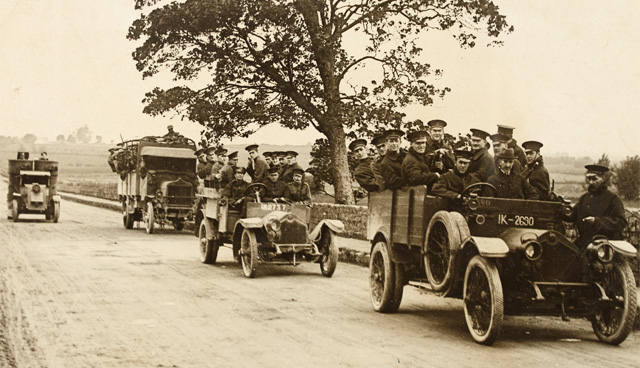Come out ye Black and Tans

With #BlackandTans trending at number one on Irish Twitter and The Wolfe Tones’ ‘Come Out Ye Black and Tans’ topping the iTunes charts in both the UK and Ireland, public backlash forced the Government into a humiliating volte-face over a proposed State commemoration. QUB’s Marie Coleman considers why Irish society is not ready to commemorate the RIC and the DMP.
The Government was forced into an embarrassing climb down in deferring its commemoration of the Royal Irish Constabulary and the Dublin Metropolitan Police, the police forces which operated in Ireland during British rule and prior to partition and independence. The event had been scheduled to take place in Dublin Castle (the administrative headquarters of British rule between 1901 and 1922) on Friday, 17 January, 2020, and would have been addressed by the Minister for Justice, Charlie Flanagan, TD, and Garda Commissioner, Drew Harris.
It soon became clear that the Government had misjudged seriously the depth of public feeling regarding the legacy of British rule in Ireland. The Fianna Fáil Mayor of Clare, councillor Cathal Crowe, was the first of a number of invited public representatives who announced their intention to boycott the event. This was followed in quick succession by other defections, including that of Dublin City Council, which voted against being represented by 38 votes to 10.
Responding with regret to the resulting cancellation, Charlie Flanagan bemoaned the fact that the RIC had been airbrushed from history, an opinion that fails to take account of the rich academic literature on policing in nineteenth and twentieth century Ireland that has been especially strong in published monographs and academic journals over the past 20 years. It is categorically not the case that either the RIC or the DMP have been ignored by historians.
However, the general public does not as a rule read academic monographs or journal articles, so much of this more nuanced examination of the history of policing remains restricted to academic circles. Wider public attitudes to the RIC and DMP are formed and influenced by their portrayal in popular media and in school text books. Most citizens will probably first have learned of the existence of these forces from the latter. An examination of how the police were portrayed in school text books goes a long way to explaining the hostility of the Irish public to the proposed commemoration of the police.
Where images of the police appeared in school history text books it was of burly RIC officers over-seeing evictions during the land war of the 1880s, the DMP baton-charging trade union supporters in central Dublin during the 1913 lock-out, and the arrival of the Black and Tans in 1920. Little wonder then that a public raised on such a demonisation of these forces would question why there were suddenly deemed worthy of commemoration by the same State whose very education system had spent a century portraying them in such a negative light.
Such a portrayal reflects the fact that from its origins the new State distanced itself from the RIC. The new police force, An Garda Síochána, was a ‘civic guard’ – more of a community-based force than the armed gendarmerie which it replaced. Crucially it was an unarmed force, a move designed to gain greater acceptance by appearing less threatening and also to avoid it becoming a legitimate target for opponents of the new state as the RIC had become for the IRA in 1920. Even its uniforms were a different colour, opting for blue rather than the old bottle-green of the RIC.
For many years after independence having had an ancestor in the RIC was badge of shame for many in Ireland. Political opponents of the charismatic Minister for Health and TB campaigner, Dr Noël Browne, used the fact of his father’s service in the RIC to vilify him during election campaigns. The same could be said of ancestors of Irish nationalists who had fought in the First World War, yet the recent centenary commemoration of the Great War did not result in the same level of hostility.
These differing responses possibly led the Government into a false sense of security, failing to recognise the significance of the distinction between Irish men wearing British uniforms while fighting Germans and Turks in continental Europe, and Irishmen in similar uniforms shooting fellow Irish men on home soil.
The timing of the proposed commemoration for January 2020 also left much to be desired. January 1920 marked the beginning of a serious assault on all visible manifestations of British law and order in Ireland by the Irish Republican Army at the start of the most intense phase of the Irish War of Independence (from January 1919 to July 1921).
In the first half of 1920, the IRA destroyed 30 courthouses, 343 vacated and 12 occupied RIC barracks; a further 104 unoccupied and 24 occupied RIC barracks were also attacked and damaged but not destroyed. Combined with the social ostracisation of the RIC instituted by the republican Dáil Éireann in 1919 many RIC, the vast majority of whom were Irish Catholics, resigned from the force creating a manpower crisis that necessitated the introduction of the Tans and Auxiliaries.

An Taoiseach’s view that the event’s cancellation was ‘a setback for Irish unity’ highlights the problematic use of commemoration of the past for current political ambitions. The comment indicated clearly that the impetus for the commemoration had less to do with the history of policing in Ireland than the demands of Anglo-Irish relations and the desire to pacify unionists.
This was the first time when the role of Northern Ireland emerged in the discussion of the commemoration. Those of us living in the North, and a number of southern historical commentators such as Brian Hanley, were struck by the southern-focused nature of the debate, both among proponents and opponents; much was said about the Tans and Auxiliaries, but comparatively little about the third auxiliary police force that operated in Ireland during the conflict of 1920-22 – the Ulster Special Constabulary.
Claims by government ministers, such as Heather Humphreys, that the commemoration had nothing to do with the Black and Tans, are historically illiterate. The nature of the RIC and its relationship to the Tans, Auxiliaries and Specials would have made such an à la carte commemoration impossible; the RIC could not have been divorced from these other forces for politically convenient commemorative purposes.
It appears that some have forgotten that the RIC have been commemorated as part of the decade of centenaries, quite recently and successfully. A local event held in Tipperary in January last year marked the Soloheadbeg ambush, and that commemoration included remembrance of the two Irish Catholic RIC officers who were killed by the IRA during the ambush. Crucially the impetus here came from within the local community.
If any lesson is to be learned from ‘RIC-gate’ that might contribute towards a more harmonious approach to commemorating the contentious dates which lie ahead perhaps it is that the nature format and timing should not be imposed from above by government but be delegated to families and local people in the communities that were affected.
Dr Marie Coleman is a Reader in modern Irish history at Queen’s University Belfast





